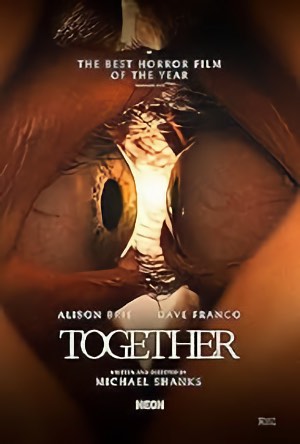
Together
The Body Horror film subgenre tends to fall into two categories: Relevant/Statement, such as the 2024 satire The Substance, which skewered the obsessive excesses of the show business youth fixation in a very meta excessive fashion, or blithefully mindless grotesqueries like the segment “The Lonesome Death of Jordy Verrill” in Creepshow (1982) which made no pretense of striving for social significance. When I decided to see Together, I was of two minds. Struggling with the inevitable gross-out factor yet still intrigued by the premise, I wound up having a private screening at the local multiplex. The film had already been in theaters for some weeks and the showtime I selected was early in the day. It was interesting to watch a movie that concerns two people whose attachment for one another becomes literal, while being aware that that I was totally solo in the theater. The movie insightfully plays upon the three “C” words liberally applied when defining intimate relationships: “Complacency,” “Co-Dependency,” and “Commitment.” But it is still basically a horror flick serving up the required appalling imagery in spades.
When first introduced to the characters of Tim, played by Dave Franco, and Millie, portrayed by Alison Brie, it is obvious that there is friction between them. By her request (demand?) they are relocating to a rural environment. At their moving away party, Millie gets down on one knee and proposes to Tim. His lack of response says volumes, and the awkward moment is beautifully captured by Franco and Brie as well as the ensemble cast. Kudos to director Michael Shanks for making the uneasiness so palpable. Shanks also wrote the screenplay, which features incisive dialogue and clever scenarios. Where writer Shanks falls short is in the employment of the so-called MacGuffin, an insignificant insert/device that propels the plot and motivations. The Holy Grail in the Arthurian legends is often cited as an early example of a MacGuffin. In the case of Together, it’s the story’s explication of how and why Tim and Maggie suddenly find their emotional entanglement turned into anatomical attachment. As in too many horror narratives, there is an unwieldiness in explanation that detracts from otherwise intelligent scenes. For example, Shanks pulls off a segment that includes a dinnertime discussion of Plato and finding “one’s other half,” that isn’t inaccessible or overly intellectual in context. In contrast, the movie’s MacGuffin just comes across as lazy genre writing.
My overall appraisal of the film? Well, I’m torn. In terms of profound shock value, there’s an intense sex scene that takes place in the confines of a school bathroom stall that will stick with me for multiple reasons. And, as previously noted, Franco and Brie, who are married in real life, do a fine job conveying the complexities of sharing one’s life with another. The multiple members of the movie’s sound department deserve a shout-out for attention to detail and making even commonplace sounds seem menacing. But still, I wanted more from the film. It is admirable for astute appraisal of the pitfalls of coupling and, when viewed as an allegory, it works quite well. The problem is the clumsy MacGuffin which cheapens the high notes. This has become a cinematic cliché in genre films and is comparable to the movie’s subtext: familiarity can breed contempt.

